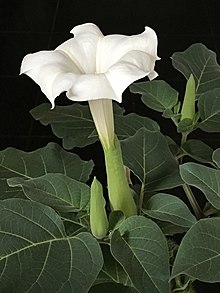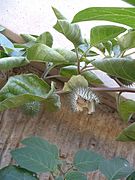Datura innoxia
| Datura innoxia | |
|---|---|

| |
| In cultivation | |
| Scientific classification | |
| Kingdom: | Plantae |
| Clade: | Tracheophytes |
| Clade: | Angiosperms |
| Clade: | Eudicots |
| Clade: | Asterids |
| Order: | Solanales |
| Family: | Solanaceae |
| Genus: | Datura |
| Species: | D. innoxia
|
| Binomial name | |
| Datura innoxia | |
| Synonyms | |
|
Datura inoxia (orthographic variant) | |
Datura innoxia (often spelled inoxia), known as pricklyburr,[1] recurved thorn-apple,[2] downy thorn-apple, Indian-apple, lovache, moonflower, nacazcul, toloatzin, toloaxihuitl, tolguache or toloache, is a species of flowering plant in the family Solanaceae. It is more rarely called sacred datura, a common name which is applied more often to the closely related Datura wrightii. It is native to the Southwestern United States, Central and South America, and introduced in Africa, Asia, Australia and Europe. The scientific name is often cited as D. innoxia.[3] When English botanist Philip Miller first described the species in 1768, he misspelled the Latin word innoxia (inoffensive) when naming it D. inoxia. The name Datura meteloides was for some time erroneously applied to some members of the species, but that name has now been abandoned.[4]
Description
Datura innoxia is a
The flowers are white, trumpet-shaped, 12–19 cm (4.5–7.5 in) long.[8] They first grow upright, and later incline downward. It flowers from early summer until late fall.
The fruit is an
In Europe often confused with Datura wrightii, for the distinction see that species.
Similar species
Datura innoxia is quite similar to
Nomenclature
The currently-accepted botanical name for this plant is Datura innoxia, in spite of the fact that many references spell it Datura inoxia. According to Tropicos, a widely accepted authority on botanical names, the inoxia form is due to an error originally made by 18th-century taxonomist Philip Miller, and since corrected.[9][10]
Miller wrote that the "not noxious" name refers to the soft spines on the fruit, which are in contrast to the sharp spines on other Datura species. (Miller refers to the ... "oval fruit, covered with long, soft, innocent spines" ...).[11]
Toxicity
All parts of Datura plants are toxic, containing dangerous levels of
Uses
When
Datura innoxia, like other Datura species, contains the highly toxic
Datura intoxication typically produces a complete inability to differentiate reality from fantasy (delirium, as contrasted to hallucination);
It has also been planted throughout the world as an
See also
References
- ^ USDA, NRCS (n.d.). "Datura inoxia". The PLANTS Database (plants.usda.gov). Greensboro, North Carolina: National Plant Data Team. Retrieved 17 January 2016.
- ^ BSBI List 2007 (xls). Botanical Society of Britain and Ireland. Archived from the original (xls) on 2015-06-26. Retrieved 2014-10-17.
- ^ "Jimsonweed-Nightshade Family". drkaae.com. Retrieved Jun 21, 2020.
- ^ ISBN 978-1-55209-598-0.
- ^ "DATURA INOXIA SEEDS (Downy thorn-apple, Indian-apple, Moonflower, Sacred datura, Datura innoxia, Datura meteloides, Thorn Apple, Moonflower, Toloache, Jimson Weed, Angel's Trumpet, Stinkweed, Pricklyburr) - Plant World Seeds". www.plant-world-seeds.com. Retrieved Jun 21, 2020.
- ^ "TrekNature | Datura inoxia Photo". www.treknature.com. Retrieved Jun 21, 2020.
- ^ Annapoorani, S. Grace (April 2013). "An Eco-Friendly Antimicrobial Finish Using Datura Innoxia and Leucas Aspera on Cotton Fabric". International Journal of Scientific Research(IJSR). 2 (4).
- ^ "Datura inoxia_Desert Thornapple_EOL".
- ^ "Tropicos / Name - !Datura innoxia Mill". Tropicos website. Missouri Botanical Garden. Retrieved 2017-03-20.
- ^ "Catalogue of Life: Datura innoxia P. miller". Catalogue of Life website. Catalogue of Life. 2017-02-27. Archived from the original on 2017-03-21. Retrieved 2017-03-20.
- ^ Philip Miler. The Gardeners Dictionary: . . . eighth edition Datura no. 5. 1768. [1]
- ^ Richard Evans Schultes (1970-01-01). "The plant kingdom and hallucinogens (part III)". pp. 25–53. Retrieved 2007-05-23.
- ^ "Erowid Datura Vault : Effects". Erowid. Retrieved 1 June 2010.
- ^ "Suspected Moonflower Intoxication (Ohio, 2002)". CDC. Retrieved September 30, 2006.




